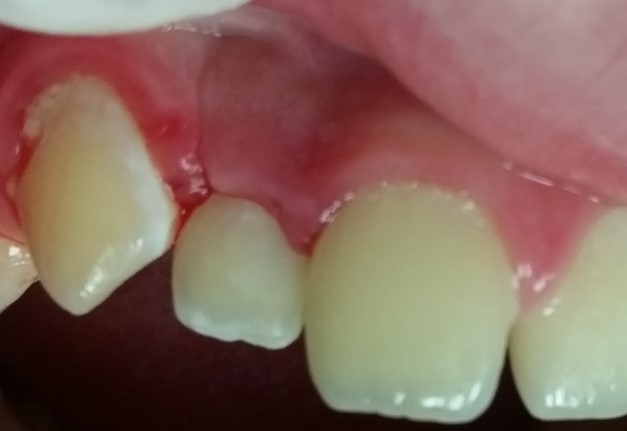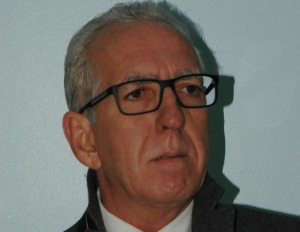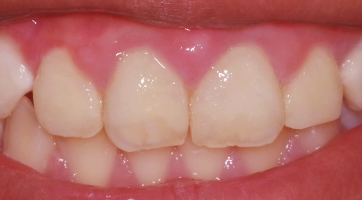By Dr. Frank Milnar
To place an effective Class V restoration, it is important to understand how teeth absorb and distribute stress. According to Milicich and Rainey, “stress distribution in human tooth structure can be visualized through the use of Moiré fringes,” which show the “peripheral rim of enamel transferring occlusal load directly to the root of the tooth.” The load on the incisal edge of a tooth moves vertically and then horizontally to the DEJ before transferring vertically and accumulating in the Class V area where the enamel is at its thinnest (approximately 0.3 millimeters). The cervical third of the tooth absorbs the greatest stress, which can cause adhesive delamination.
To ensure best outcomes in Class V restorations, I have started using ACTIVA BioACTIVE-RESTORATIVE, which contains a patented rubberized resin that is more fracture resistant than traditional composite materials. According to the manufacturer the toughness of ACTIVA, measured by deflection at break, is 2-3 times greater than composites and 5-10 times greater than GIs and RMGIs. The material exhibits high compressive and diametral tensile strength while also having very low wear. In addition, ACTIVA BioACTIVE is hydrophilic, making it ideal for Class V restorations and other instances where it is difficult to ensure a dry field.
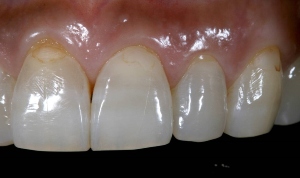
The patient presented with several failing Class V restorations. The pre-operative image of tooth #8 indicates a cervical abfraction and failing composite restoration (Figure 1). The tooth was prepared using rotary abrasion with the goal of exposing prismatic enamel to promote micromechanical retention and leverage the bond strength of enamel. Figure 2 shows the preparation with a radius bevel.

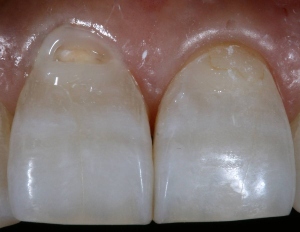
The peripheral rim of enamel around the Class V restoration can be considered a tension ring (Milicich G & Rainey J) which, when properly reinforced, can mitigate the occlusal forces accumulating in the Class V area. Similar to caulking a window, an adhesive seal was placed around the preparation (Figure 3). The adhesive was placed first on the gingival margin followed by a 10 second light cure, then the top of the “window” was “caulked” and sealed with a 10 second light cure, and finally each side was “caulked” and sealed before light curing for 10 seconds. After “caulking the window” the final restoration was placed using ACTIVA BioACTIVE-RESTORATIVE. The material was back filled into the preparation and placed slightly beyond the radius bevel, and then finished and polished. Figure 4 shows the final restoration.
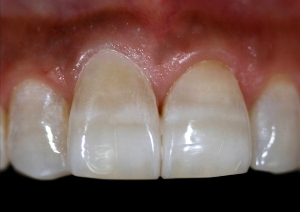
Reference
Milicich G, Rainey J. Clinical presentations of stress distribution in teeth and the significance in operative dentistry. PPAD 2000; 12 (7): 695-700.
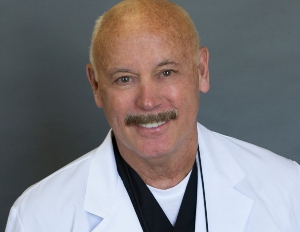
About Dr. Frank J. Milnar
Frank J. Milnar DDS, AAACD is a graduate from the University of Minnesota, School of Dentistry in 1976. He is an Accredited member of the American Academy of Cosmetic Dentistry, Board Examiner for Accreditation and Diplomat of the American Board of Cosmetic and Esthetic Dentistry. Dr. Milnar maintains a full-time practice in St. Paul, Minnesota emphasizing Minimally Invasive and appearance related dentistry. He has published over 50 peer reviewed articles about the direct placement of composites, shade selection and porcelain materials and is on editorial review boards for dental journals. Dr. Milnar is co-founder of the Minnesota Academy of Cosmetic Dentistry and has lectured extensively within the US Armed Forces as well as internationally on the subject of direct composite restorations, shade selection and porcelain materials. He has been voted “Top Dentist” and voted into the” Top Dentist Hall of Fame” for the last five years by his peers in the Minneapolis/St. Paul Magazine.He has been voted by Dentistry Today as one of the top 100 dentists contributing to dental education. Most recently, Dr.Milnar was nominated to the University Of Minnesota School Of Dentistry Continuing Education Advisory Board and is a Visiting Faculty Member for the BIOCLEAR Learning Center.


